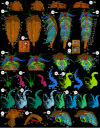A vicissicaudatan arthropod from the Silurian Herefordshire Lagerstätte, UK
- PMID: 37538743
- PMCID: PMC10394423
- DOI: 10.1098/rsos.230661
A vicissicaudatan arthropod from the Silurian Herefordshire Lagerstätte, UK
Abstract
A new arthropod, Carimersa neptuni gen. et sp. nov., is described from the Silurian (Wenlock Series) Herefordshire Konservat-Lagerstätte, UK. The head bears pedunculate eyes and five pairs of appendages. Triflagellate antennae are followed by two pairs of uniramous limbs each with an endopod bearing a pronounced gnathobasic basipod. The posterior two pairs of head limbs and all trunk limbs bear an endopod, exopod and filamentous exite. The trunk consists of 10 appendage-bearing segments followed by an apodous abdomen of four segments. The arthropod resolves as sister taxon to Kodymirus and Eozetetes + Aglaspidida. It is the first representative of Vicissicaudata reported from the Herefordshire Lagerstätte and the first Silurian example with well-preserved appendages. The preservation of a cluster of radiolarians apparently captured by the trunk appendages is the first direct association of predator and prey discovered in the Herefordshire fauna, and suggests that Carimersa was a nektobenthic form that used its gnathobasic basipods in microdurophagy.
Keywords: Arthropoda; Herefordshire Konservat-Lagerstätte; Nekton; Silurian; Vicissicaudata.
© 2023 The Authors.
Conflict of interest statement
We declare we have no competing interests.
Figures


References
-
- Orr PJ, Briggs DEG, Siveter DJ, Siveter DJ. 2000. Three-dimensional preservation of a non-biomineralized arthropod in concretions in Silurian volcaniclastic rocks from Herefordshire, England. J. Geol. Soc. Lond. 157, 173-186. (10.1144/jgs.157.1.173) - DOI
-
- Siveter DJ, Briggs DEG, Siveter DJ, Sutton MD. 2020. The Herefordshire Lagerstätte: fleshing out Silurian marine life. Jl Geol. Soc. Lond. 177, 1-13. (10.1144/jgs2019-110) - DOI
-
- Sutton MD, Briggs DEG, Siveter DJ, Siveter DJ. 2001. Methodologies for the visualization and reconstruction of three-dimensional fossils from the Silurian Herefordshire Lagerstätte. Palaeont. Electron. 4, art. 2.
-
- Sutton MD, Garwood RJ, Siveter DJ, Siveter DJ. 2012. SPIERS and VAXML: a software toolkit for tomographic visualisation, and a format for virtual specimen exchange. Palaeont. Electron. 15, 5T, 14. (10.26879/289) - DOI
-
- Spencer ART, Garwood RJ, Sutton MD. 2020. Palaeoware/SPIERS: SPIERS v3.1.0. Zenodo. (10.5281/zenodo.3859623) - DOI
Associated data
LinkOut - more resources
Full Text Sources

